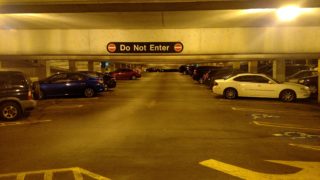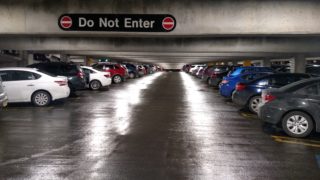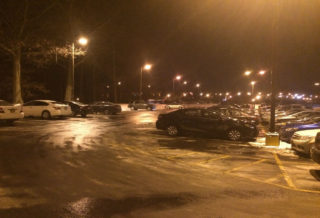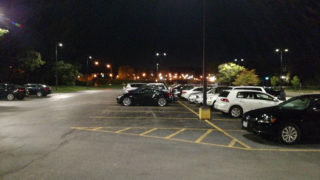University Facilities and Services is always looking for ways to make sustainable improvements. This past year, numerous LED retrofitting projects have been completed, replacing outdated lights with more sustainable ones, saving energy and money.
LEDs, or light-emitting diodes, are semiconductor devices that produce visible light when an electrical current passes through them. LED lights are considered more sustainable than compact fluorescent lamps (CFLs) or incandescent bulbs because they are more efficient, durable, versatile, and longer lasting. According to the Department of Energy, residential LEDs—especially ENERGY STAR rated products—use at least 75% less energy, and last 25 times longer, than incandescent lighting. About 95% of the energy in LEDs is converted into light and only 5% is wasted as heat.
The heat produced to illuminate an LED light is absorbed into a heat sink. On the other hand, incandescent bulbs produce light using electricity to heat a metal filament until it becomes “white” hot or is said to incandesce. As a result, incandescent bulbs release 90% of their energy as heat, which is a significant waste of energy. In a CFL, an electric current flows between electrodes at each end of a tube containing gases. This reaction produces ultraviolet (UV) light and heat. The UV light is transformed into visible light when it strikes a phosphor coating on the inside of the bulb.
LEDs have been installed in numerous locations at the University. Under the direction of Senior Director of University Facilities and Services and Parking and Transportation Management Jeff Foster, Director of Transportation & Parking Management Hugh Kierig, and Field Manager Doug Grotke, the incandescent lights in and surrounding the Medical Center parking garage have been replaced with LED lights. Additionally, the lights on the outside of the parking garage have been placed on a sensor so they will turn off during the day and turn on at night. This project will save about 1,016,625 kWh of electricity and $81,330 in energy and maintenance costs per year with a payback period of only three years. In addition to the money and energy saved, the new LEDs provide better quality lighting which increases visibility and public safety (see “before” and “after” pictures below).


The lights in Danforth Dining Center, Rush Rhees Library Room 354, in the common areas of some Hill Court buildings, and in multiple River Campus parking lots were also replaced. The changes in Danforth will save an estimated 9,461 kWh and $756 per year and in Rush Rhees Library Room 354, an estimated 40,727 kWh and $3,258 per year. In Hill Court, under the direction of Planning, Scheduling, and Estimating Coordinator Kris McGee, retrofits in Gale and Fairchild will amount to a 23,825 kWh and $1,906 per year reduction. Thanks to Global Maintenance Supervisor Eris Oleksyn, the new LED lights in Trustee Lot, Riverside Lot, and Bridge Lot will save 86,400 kWh and $6,900 a year. As with the Medical Center parking garage, the LED lights also make these parking lots safer at night since they are brighter than the incandescent lights that were previously in these lots (see “before” and “after” pictures below).


Plans are also being made to upgrade lights in the Robert B. Goergen Hall for Biomedical Engineering and Optics, the Memorial Art Gallery, and Hoyt Hall Auditorium. Planned retrofits in Goergen Hall will save a total of 30,330 kWh per year. In Hoyt Auditorium, not only will the lights be replaced, but a control panel will be incorporated into the main podium, allowing professors to control the lighting all over the room as well. This project will save 70,438 kWh of electricity and $5,635 each year. To retrofit the lights in the Memorial Art Gallery, staff from Facilities and Services are working closely with museum curators to install lights that will preserve the artifacts on display while also saving energy.
As Facilities Condition Assessment Program Manager Joseph Viterna states, “We are trying to do anything and everything to save energy at the University. Replacing old lights with LEDs saves energy, money, and reduces maintenance.”
University Facilities and Services plans to replace all the lights in the residential buildings with LED lights over time, beginning with common areas such as stairwells, hallways, and bathrooms and eventually in student rooms.
Written by Alyssa Lemire, Class of 2017


Thanks for sharing this. I would like to add few why you need to invest in led lights.
1. Ecologically Friendly – LED Lighting Is Much More Eco-Friendly
LED lights are free of toxic chemicals. Most conventional fluorescent lighting bulbs contain a multitude of materials like e.g mercury that are dangerous for the environment.
LED lights contain no toxic materials and are 100% recyclable, and will help you to reduce your carbon footprint by up to a third. The long operational life time span mentioned above means also that one LED light bulb can save material and production of 25 incandescent light bulbs. A big step towards a greener future!
2. Durable Quality – LED Illumination Can Withstand Rough Conditions
LEDs are extremely durable and built with sturdy components that are highly rugged and can withstand even the roughest conditions.
Because LED lights are resistant to shock, vibrations and external impacts, they make great outdoor lighting systems for rough conditions and exposure to weather, wind, rain or even external vandalism, traffic related public exposure and construction or manufacturing sites.
3. Zero UV Emissions – LED Lighting Features Close to No UV Emissions
LED illumination produces little infrared light and close to no UV emissions.
Because of this, LED lighting is highly suitable not only for goods and materials that are sensitive to heat due to the benefit of little radiated heat emission, but also for illumination of UV sensitive objects or materials such a in museums, art galleries, archeological sites etc.
4. Operational in Extremely Cold or Hot Temperatures
LED are ideal for operation under cold and low outdoor temperature settings. For fluorescent lamps, low temperatures may affect operation and present a challenge, but LED illumination operates well also in cold settings, such as for outdoor winter settings, freezer rooms etc.
5. Low-Voltage – LED Lighting Can Run on Low-Voltage Power Supply
A low-voltage power supply is sufficient for LED illumination. This makes it easy to use LED lighting also in outdoor settings, by connecting an external solar-energy source and is a big advantage when it comes to using LED technology in remote or rural areas.